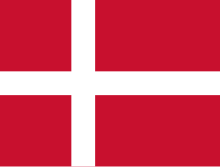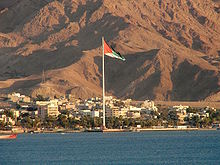Flag
A flag is a piece of cloth, usually rectangular, although it can take many different shapes, which is attached to a pole on one side or hung from a halyard. It is used to identify or represent a person or group of people. It can also serve to transmit signals to communicate. The study of flags is known as vexillology.
Etymology
The term flag is considered to have Germanic etymology, coming from the Franconian German bind (tie, ribbon) passing into Spanish through the French Romance language through the form bande. The "band" or flag was the banner or emblem of a group of people (for example, a "band" of people).
History
It is possible to consider the vexilos (word origin of the term vexillology) used by legionaries during the Roman civilization as the first standards used in Europe. The Visigoths continued to use this type of rigid veil with some kind of cloth; but it was not until the Muslim conquest of the Iberian Peninsula and the first crusades that what we currently know as "flags" began to be used in Europe, since the use of light fabrics, such as silk, in The ensigns originated in the East, with the Muslims and the Crusaders being the first to implement their use in Europe.[citation needed] The flags became scripts and representative banners of Kings and Lords (specifically, of their lineages or royal houses), rather than of territories or nations. As the national flag, the Dannebrog or Danish flag is considered to be the oldest current one.
Shape
Most widespread forms:
- Rectangular
- Square
- Corneta
- Gallardete (triangular, trapezoidal and gallardeton)
Representatives of specific people
They can represent a private citizen, or a position in the public administration or a private organization, adopting different denominations depending on the case:
- Personal flag. The best known are those used by shipowners.
- Range flag. They represent a position of a den, but not the individual in particular. This group includes mainly the flags of the military authorities, the government charges (presidents, ministers, etc.) and the posts of private entities (presidents, comodoros, captains of fleet, treasurers, secretaries, etc.).
- Guion. Flag of which "guide", usually a monarch or head of State. Its use also extended to the old military tactics of the 18th and 19th centuries, where they were employed by troops of the same name for "guiar" the passage of each battalion.
- Stand by.
Representatives of groups of people
The variety of flags that represent different groups is very wide. The main ones are:
- National flag, national pavilion and torrotito: They represent a nation. There are 193 independent countries in the world, each of which has a national flag that is waved in its own territory and its embassies abroad.
- Flag of subnational entity: Includes all representative flags of territories below the nation (regions, provinces, communities, districts, municipalities, parishes, neighborhoods, etc.).
- supranational flag: Flag of agencies such as the United Nations, the European Union or NATO, for example.
- Private flag: Includes representative sports clubs, foundations, associations, costumes, companies, etc. They may be national or international groups.
Signal flags
Signal flags are used in the maritime field both in the merchant marine and in the military and in the recreational one.
In other areas, such as sports competitions or beach rescue services, specific signal flags are also used.
Protocol
Honours to the flag
Depending on the country, there are various uses or prescriptions on the use and treatment due to the flag, according to traditional etiquette rules. For example, the protocol may mark certain rites and dignified observations regarding the replacement of an old flag, which may include a ceremony, the correct folding of the flag, and finally a cremation, sometimes accompanied by the national anthem. Observations to the flag in some cultures tend to be more lax than in others, depending, in general, on the political regime of the country.
There are also hierarchies in the order of placing the flags, in the event that more than one is displayed. According to the commonly accepted custom, the hierarchy of the flags is done from their point of view, that is, placed behind them. If the number of flags to be waved is odd, the main one will be placed on the central mast, and the others will be placed in alternate order to the right and left respectively of the central one, further from it as their level decreases. If the number of flags is even, the main one will be located on the right of the two central masts, the second on the left, and so on to the right and left.
In cases where there are a large number of masts, for example in international organizations or congresses, it is common to see the flags arranged linearly, starting from the left, where the main one is located, and so on to the right, within the hierarchy considered convenient.
In occasions in which several flags of the same level are hoisted, without hierarchies between them, different methods can be established to order them. For example, in the case of the flags of the Spanish autonomous communities, the order that governs is that of the date of their accession to autonomy; When the flags of the Ibero-American Community of Nations are flown together, alphabetical order is usually used to order them.
In the case of official visits by a head of state or government to another country, it is customary to raise the flag of the visitor flanked by two flags of the host country, as a sign of friendly welcome.
In Mexico, according to the Ministry of the Interior, the flag accompanied by the coat of arms and the national anthem represent the values and history of the peoples that, added to the customs and traditions, consolidate a sense of belonging and contribute to building a identity.
The flag upside down
Showing the flag upside down is considered in many countries contempt punishable by law, as well as other denigrating actions (stepping on it, burning it, dirtying it, etc.).
In wartime, the inverted flag can have a particular meaning:
The first indicates that it is a way of declaring surrender before a foreign armed force. In fact, if an armed force takes a square and for whatever reason does not have its own flag, it can raise the enemy flag of the square taken upside down, to indicate to its allied forces that the position is surrendered or taken, that it is no longer hostile.[citation needed]
The second version is a variation of the first and indicates that turning the flag upside down and hoisting it at a representative point, that is, on the mast of a ship or on the pole of a building, means a request for help due to mutiny, kidnapping or currently terrorism. It is an ancient device for warning friendly troops that were coming when a fort was taken so that they would not be ambushed.[citation needed]
Mourning
One of the signs of official mourning in a city, region or country is to fly their flags at half mast on official buildings. When a flag cannot be hoisted at half mast because the mast does not allow it, or because it is an indoor flag, a black crepe is placed on the cloth as an equivalent measure. You should never do both things at the same time (wear crepe if the flag is already flying at half mast).
Since 2007, the exception to this rule of protocol was established by Iran, where a presidential order considered that the hoisting of its flag at half-mast could be an offense since it contained the name of Allah. In its place, it was established that together the flag would fly another black color.
Use
In some nations it is required by law to lower the flag at night, if a beam of light is not provided to illuminate it. It should also be lowered when rain or wind can damage it.
Larger flags on masts
The world's tallest flagpole is the Dushanbe (Tajikistan) flagpole, which is 165 meters high and carries a 30m x 60m (1800sqm) Tajikistan flag. Second tallest flagpole in the world It is located in the National Flag Square of Baku, Azerbaijan, and is 162 meters high, and a 35 m x 70 m (2,450 m²) Azerbaijani flag is hoisted on it, thus its flag is larger than the Although it is a mast, since its only purpose is to raise a flag on it, its structure is like a tower, so there is great controversy about the third inclusion of the Kijŏng-dong mast-tower (North Korea), with its 160m high, although its flag is relatively small.Fourth place is occupied by the 133m Ashgabat flagpole, with its Turkmenistan flag.Fifth, 132m, is that of Aqaba (Jordan), and the sixth, at 125 m, is the Raghadan pole, from Amman, also in Jordan, with its 30 m x 60 m (1800 m²) flag.
Other meanings of the term "flag"
- It is known as "bandera" a typical dish in the Republic of Ecuador that is composed of several portions of other typical dishes. Thus, it can be carried on the same dish: a portion of slices of cooked intestines (plate known as guatita), a portion of shrimp ceviche, a portion of shell ceviche, a portion of fish salad. Depending on the region, the ingredients may vary or increase. All this is usually accompanied by white rice. Another food known as the flag are Mexican sweets made of ralled coconut, which are given the colors of the Mexican flag.
- It is called "bandera" to a territorial division in the People's Republic of China, specifically in the Autonomous Region of Inner Mongolia.
- It is called "bandera" to the unit, similar to that of a battalion, in which a Tercio is divided.
Contenido relacionado
Juan Peyro Urrea
Annex: IX edition of the Goya Awards
Mythology







